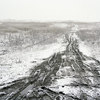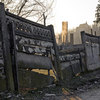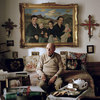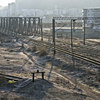A Conversation with Helena Schätzle
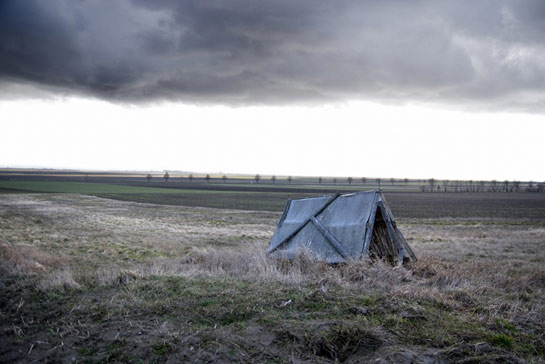
It is one of those coincidences that around the time I published my posts about German photography right after the war (part 1, part 2), I came across the work of Helena Schätzle, The time in between. Of course, I was curious to learn more about it, so I approached Helena and asked her whether she would be willing to talk about the work. Find the conversation below. (more)
Jörg Colberg: For The time in between you used your grandfather’s diary who experienced World War II in Germany, Austria, Hungary, Romania, Poland, Czechoslovakia, Ukraine and Russia. Did you know your grandfather personally? How did you come across his diary, and what made you travel to all those different locations to take photographs?
Helena Schätzle: Today my grandfather is 88 years old and he is still alive. My grandfather can only write using old German characters, Sütterlin. Therefore, some time after his return my grandmother helped him to write down his war experiences. It is written in a pretty impersonal and rather informative way. Reading it made me curious to know more, more about how he felt, what he had done and gone through.
But through my questions I was unable to find out much more than what I already knew, since he would come back again and again to the same stories. Then I had the idea to travel and search for witnesses of the war, to hear and understand more. Whilst my grandfather experienced one side, at the very same time at the very same place other people had completely different experiences.
Due to a lack of funds I had to decide on a time period to concentrate on. I guess because it was more easily available, easier to listen to and also because it was the story I grew up with I concentrated on the time directly after the war, May 1945 - February 1946, which included my grandfather’s way into the POW camps, his escape and and way back home to Germany.
Then during my travels to Austria, Slovakia, Czech Republic, Hungary and Romania, I learned that many people in those places had fought on the German side. That made me realize that I had to extend the project to the countries where my grandfather had actually fought as a soldier. By extending the project to Ukraine and Russia I finally got to hear stories, which happened at the same time at the same place as my grandfather’s, but from a completely different perspective, the perspective of the victims of war.
JC: Did you show your photographs to your grandfather? Or did you talk to him about what you were doing and why you were doing it?
HS: Yes, I shared my experiences and photographs with my grandfather. He is not very talkative, so he didn’t really comment on other people’s stories. All I managed to find out was that he was somewhat familiar with the places I went to. But I know emotionally it wasn’t easy for him. During the period of time I did the work, he was often sick due to malaria, which he had been infected with during World War II.
JC: You were born in 1983, many years after the end of World War II, and many of its active participants are either very old now or already dead. I’m curious to hear why you wanted to engage with the subject matter.
HS: Right now is the last opportunity for me to be able to meet witnesses of the war, to listen to their stories and show those through my photography. I grew up in Germany, and even though I was been born a long time after World War II, it is the sad part of my heritage. For me it is very important that people do remember that time and learn from it. And even though there are many examples in this world that show that people don’t seem to learn, by traveling though Eastern European countries it became clear to me that change is possible. This shows in the way countries and people who were enemies in the past are friends now, it shows in the way I was welcomed there.
JC: Were/are you interested in also talking to and/or portraying other Germans from your grandfather’s generation?
HS: I actually did portray some Germans already, but only in two towns my grandfather came through on his way back to his hometown Markdorf. I am still planing to visit two more cities in Germany where my grandfather spent time as a soldier.
JC: When you looked for witnesses in all these other countries, what reactions did you run into? Were people happy to talk about what they had experienced, or did they want to leave the past behind?
HS: I was surprised that most old people were happy to share their personal stories. Mostly they felt that nobody really was interested in them, and they were glad to meet somebody from the younger generation asking questions. Only in Russia and Ukraine some people of my own generation were skeptical, and they didn’t want to introduce me as a German to their grandparents, to protect them from their memories. But during all the meetings with the old people I was very touched by how welcoming they were towards me, no matter how horrible their experiences with Germans had been.
JC: In the (German language) introduction of this work you speak of a “lively relationship between past and present,” which shapes your subjects. Could you talk about this more?
HS: It is impossible to photograph something which already happened. Therefore, I had to find windows to the past. The most important window are old people. Even though I am photographing them today, almost 70 years later, I feel that their experiences are shown in their facial expressions, they are are written onto their bodies. The other window I found are the landscapes, which remain as consistent, silent witnesses almost the same way they existed 70 years ago.
JC: You also talk of a “narrative without a unique (or maybe ‘dominant’ would be a good word, too) voice,” which strikes me as a particularly apt way to describe this part of history. How can photography be used to show this? Is this something you arrived at after doing all the work, or did you know beforehand about it?
HS: When I started my work, I was at a different point than where I am today. I only had black and white pictures in my mind. Only after traveling and talking to people I got to see how history has many different voices, pictures and stories. By leaving my images as open to interpretation as possible I wanted to leave space for the different ways history was experienced, the different voices people talk about it. The text I use in exhibitions ads on to that.
JC: Given your experiences and your success with the series - you won an important German photo prize (Gute Aussichten) this year - do you plan to expand the work, doing more traveling, or is it done for you now?
HS: Gute Aussichten contains the first part of the project, my grandfather’s way into the POW camps, his escape and and way back home to Germany in 1945/1946. Earlier in Spring this year, because I had a little money, I had an intense journey to Russia and Ukraine, doing some research on the time when my grandfather was a soldier in World War II (1940-45). I am still planning to travel to Poland and some other parts of Ukraine and Czech Republic to complete the project. I will never be able to get a complete picture of that time, I can only capture fragments of memories. But for me the project will not be finished until I have been to all the places my grandfather went to.
 By
By 
